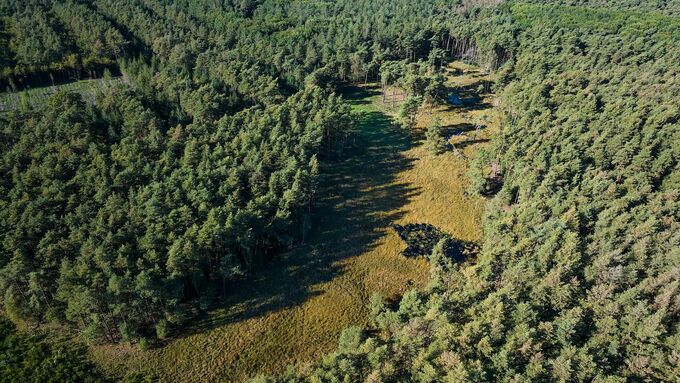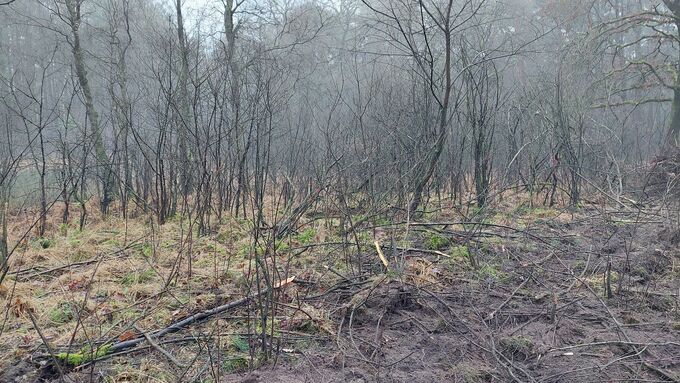Drone shot of the area in October 2023 © Martin Hochbruck
download picturemain content
Project of the month
#11/2023 (SCRUB) CLEARING OF TRANSITION MIRES AND QUAKING BOGS
Expansion of the measures in the SAC ‘Meinweg mit Ritzroder Dünen’ (district of Heinsberg)
‘Meinweg’ is a closed forest area in the districts of Viersen and Heinsberg and borders directly on the Dutch national park ‘De Meinweg’. Its bogs are of outstanding value for the physical region Lower Rhine Plain and Cologne Lowland due to the diversity of natural development stages - from open heath ponds to various forms of transitional mires to wet heath - with their species inventory and low-nutrient peculiarity.
In the first project phase - from December 2018 to March 2019 - measures to optimize the transition mires and quaking bogs (habitat type 7140) were already carried out as part of the LIFE IP Atlantic Region DE in the western part of the SAC ‘Meinweg mit Ritzroder Dünen’ near Wegberg in the district of Heinsberg. In cooperation with the Lower Nature Conservation Authority of the district of Heinsberg, the NABU nature conservation station ‘Haus Wildenrath’ and the private owner, the transition mires had been optimized by clearing the vegetation on an area of around 3.3 hectares. Pine trees standing at the edges had been removed and non-native vegetation - especially common rush (Juncus effusus) – had been removed. This has created new puddles and bog pools (habitat type 3160). The upgrading of the bog sites has also created the conditions for the moor frog (Rana arvalis) to colonise the area.
In the third phase of the project, the previous works were extended to the bog areas to the north of the ‘Ritzroder Dünen’ in the eastern part of the area. The works were carried out from January to March 2022 and, as in the first project phase, not only the core areas were considered, but also the woody plants in a corridor of 10 to 20 metres around the transitional mires were removed. In addition, the bog areas were carefully cleared of scrub. Subsequently, small water bodies were created again by removing the common rushes. The scrub clearing and removal of non-native vegetation from an area of around 2.2 hectares strengthened the typical bog vegetation and restored the function of the peat layer. A positive development was already evident in May 2022.
Further work is planned for the fourth project phase in order to ensure the long-term conservation of the important transitional mires and quaking bogs (habitat types 7140 and 3160). The further removal of remaining rushes will continue to remove undesirable nutrients from the moor.
Related Topics
Further Links
- SAC ‘Meinweg mit Ritzroder Dünen’ – Landesamt für Natur, Umwelt und Verbraucherschutz Nordrhein-Westfalen (in German) (external link opens in a new window)
- Nature Conservation Station ‘Haus Wildenrath’ (in German) (external link opens in a new window)
- Office for Environment and Transport Planning of the District of Heinsberg (in German) (external link opens in a new window)





